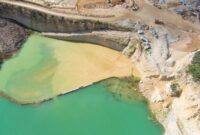The global push for sustainable energy has shifted focus toward renewable energy sources, particularly in mountainous regions. Investment in hydro and wind power in these areas is increasingly attractive due to the natural landscape’s ability to generate large amounts of clean energy. With the growing demand for greener alternatives, mountainous regions present ideal opportunities for sustainable energy projects, specifically hydroelectric and wind power. This article delves into why the investment in hydro and wind power in the mountains is a promising venture, the benefits, challenges, and the future outlook.
Why Invest in Mountainous Renewable Energy?
Hydroelectric power and wind energy are among the most effective renewable energy sources, and mountainous areas offer unique advantages for both. Mountain regions typically have abundant water resources that can be harnessed for hydroelectric power, while their high altitude and open spaces are perfect for wind farms. Investing in these forms of energy can significantly contribute to reducing carbon footprints and meeting global energy demands.
The Benefits of Hydro and Wind Power in Mountainous Regions
One of the key reasons to invest in renewable energy in mountainous regions is the high efficiency of both hydro and wind power in these environments. Hydroelectric plants use the natural flow of water, such as rivers and streams, which are commonly found in mountain regions, to generate energy. On the other hand, wind power thrives in high-altitude areas with consistent, strong winds, making mountains ideal for wind farms.
Hydroelectric Power: An Overview
Hydroelectric power relies on the gravitational force of falling or flowing water to produce electricity. Mountainous regions are home to many natural water bodies, making them prime locations for hydroelectric projects. This form of energy is not only renewable but also cost-effective in the long run, as the maintenance costs are relatively low once the infrastructure is in place.
Wind Power in the Mountains
Wind farms in mountain regions are becoming more common due to the steady, strong winds available at higher altitudes. These areas often experience fewer obstacles to wind flow, making it easier for wind turbines to operate at peak efficiency. Investing in wind energy in mountainous regions can yield high returns due to the consistent wind patterns and minimal environmental impact.
Challenges Facing Renewable Energy Investment in Mountainous Areas
While there are many benefits to investing in hydro and wind power in mountain areas, there are also challenges. The construction and maintenance of infrastructure in rugged, remote regions can be costly and complicated. Access to the sites for building hydroelectric dams or installing wind turbines is often limited, requiring significant investment in transportation and logistics. Moreover, environmental concerns must be addressed, as large-scale energy projects can disrupt local ecosystems.
Environmental and Regulatory Hurdles
Any development in mountainous areas must carefully consider the environmental impact, particularly on local wildlife and water sources. Hydroelectric dams can affect aquatic life, while wind turbines may pose a threat to birds and bats. Furthermore, the approval process for building renewable energy facilities in such regions can be lengthy, with various regulations to comply with regarding environmental protection.
Future Prospects for Hydro and Wind Power in Mountainous Regions
Despite the challenges, the future of renewable energy in the mountains looks promising. Technological advancements are helping to overcome some of the obstacles that previously limited the growth of hydro and wind power in these regions. For example, modern wind turbines are more efficient and can operate in a wider range of wind conditions, making them suitable for mountainous areas with variable wind speeds. Similarly, innovations in hydroelectric technology, such as pumped-storage hydropower, allow for better energy storage and more flexible energy production.
Governments around the world are also incentivizing investment in renewable energy through subsidies and grants, making it more financially feasible for companies to invest in these projects. The push for sustainability is not slowing down, and as the global community works toward reducing carbon emissions, investment in hydro and wind power in mountainous areas is likely to increase.
Conclusion
Investing in renewable energy in the mountains, specifically hydroelectric and wind power, presents a lucrative and environmentally friendly opportunity. These regions offer natural advantages that can be harnessed to produce large amounts of clean energy, contributing significantly to global sustainability goals. However, it is essential to consider the challenges and address environmental concerns to ensure that these projects are both economically viable and environmentally responsible. As technology continues to evolve and governments offer more support for green energy, hydro and wind power investments in mountainous regions will play a crucial role in the future of renewable energy.
FAQs
Q: Why are mountainous regions ideal for renewable energy investments?
A: Mountainous regions offer unique advantages, such as abundant water sources for hydroelectric power and high altitudes for wind power, which enhance the efficiency and output of renewable energy projects.
Q: What are the main challenges of investing in renewable energy in mountain regions?
A: The primary challenges include the cost and complexity of constructing infrastructure in remote and rugged areas, as well as environmental concerns and regulatory hurdles.
Q: How does hydroelectric power work in mountain regions?
A: Hydroelectric power in mountain regions uses the natural flow of water from rivers and streams to generate electricity through dams or turbines, making it a highly efficient form of renewable energy.
Q: Are there any environmental risks associated with wind and hydroelectric power?
A: Yes, both wind and hydroelectric power can have environmental impacts. Wind turbines may affect bird and bat populations, while hydroelectric dams can disrupt aquatic ecosystems. Proper planning and regulation can mitigate these risks.
Q: What is the future outlook for renewable energy in mountainous areas?
A: The future looks promising due to technological advancements and increased government support. Innovations in energy storage and more efficient wind turbines are making renewable energy projects in mountainous areas more viable.




